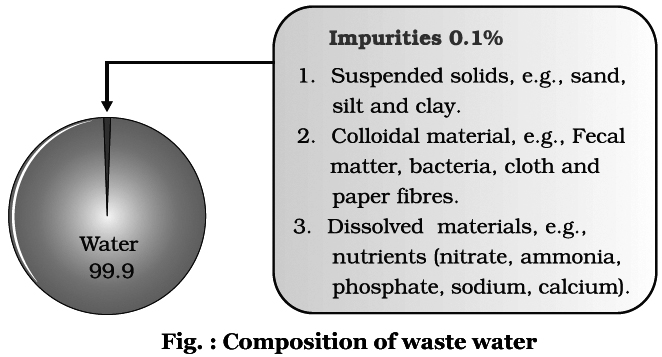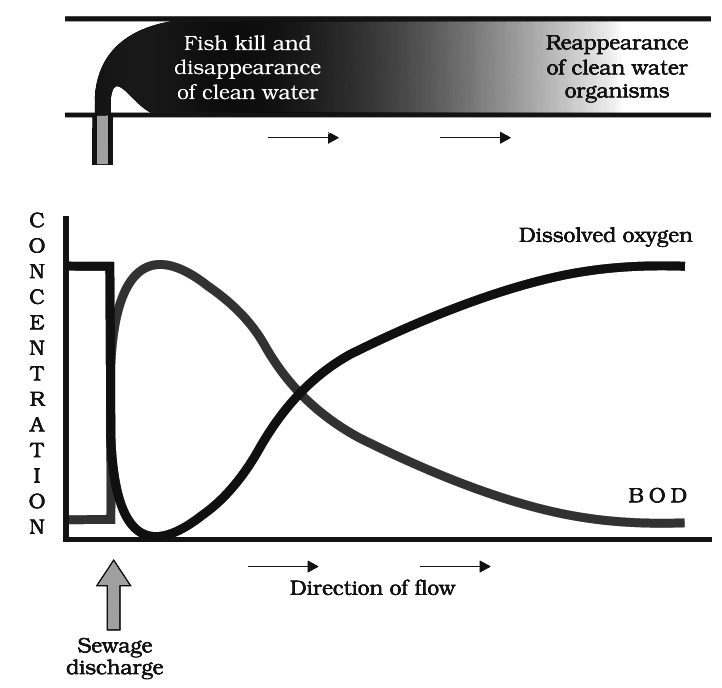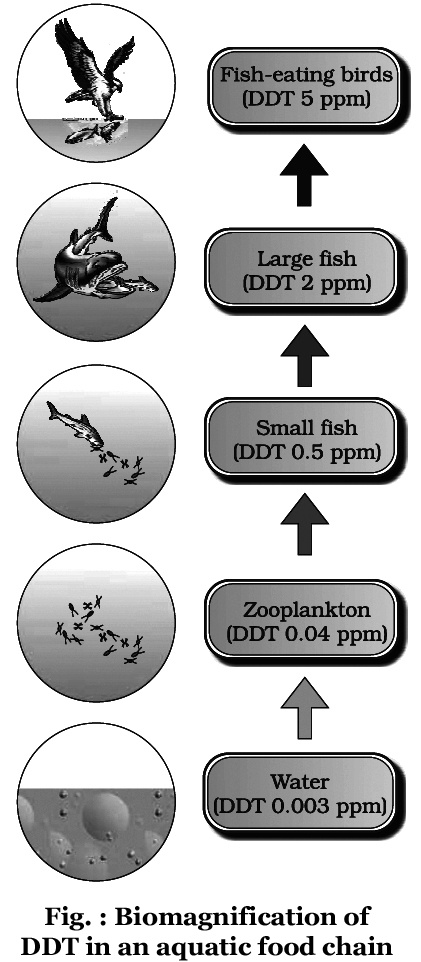- Books Name
- A TEXT OF BIOLOGY - CLASS XII
- Publication
- ACME SMART PUBLICATION
- Course
- CBSE Class 12
- Subject
- Biology
WATER POLLUTION
Water pollution may be defined as any adverse change in composition and condition of the water which tend to lower its quality and cause health hazard or makes it unfit for domestic use.
I. Sources and effects of water pollution

(i) Sewage and domestic wastes.
Nearly 75% of water pollution is due to sewage and domestic wastes.
A mere 0.1 % impurities make domestic sewage unfit for human use (Fig.).
Sewage generally includes biodegradable pollutants like human faecal matter, animal wastes and many dissolved organic compounds e.g., carbohydrates, proteins, fats, urea etc. inorganic salts such as nitrates and phosphates of detergents.
These pollutants under natural processes are rapidly decomposed.
In water, organic wastes provide nutrition for many decomposers like bacteria.
These break down the organic part by using bulk of oxygen and deficiency of oxygen (reduced DO) kills the fishes and other aquatic animals.
Anaerobic bacteria in oxygen deficient water disrupt food chains.
Anaerobic bacteria produce foul smelling gases. These give rise to many other pollutants like H2S, NH3, organic sulphides, methane etc.
These make the water brownish and turbid.
Pollution strength is characterized by its Biochemical oxygen demand (BOD).
BOD is defined as the amount of oxygen (mg) consumed by microbiological action when 1000 ml sample of water containing known amount of oxygen is incubated for 5 days at 20°C in the dark.
A high BOD indicates intense level of biodegradable pollutants.

Water having DO content below 8.0 mg/L is considered as polluted. Heavily polluted waters have DO content below 4.0 mg/L.

COD (chemical oxygen demand) indicates total O2 requirement by all the O2 consuming pollutant materials (organic and chemical compounds) present in water.
Its value is higher than BOD. Annelid worm Tubifex and some insect larvae act as indicator species for polluted waters.
(ii) Industrial wastes and effluents.
The industrial wastes and their effluents include poisonous materials like acids, alkalies, chromium salts, phenols, cyanides, insecticides, agricultural chemicals, chlorine, ammonia, hydrogen sulphides, salts of heavy metals such as of copper, lead, zinc and mercury.
The water becomes toxic and deoxygenated, so this cannot support aquatic life.
Mercury enters the food chain, kills fish and poisons the remaining fauna, mercury cause minamata disease.
People feeding on these aquatic forms develop numbness of limbs and lips, impairment in speech hearing and vision, meningitis and genetic disorders.
Oils deplete oxygen of water, inhibit plankton growth and photosynthesis.
Sea birds smeared with oil fall sick and die.
Organic phosphates and nitrates enhance growth of algal blooms.
Black foot disease is caused by chronic exposure to arsenic.
(iii) Insecticides and pesticides.
Insecticides are biologically active chemicals are used for pest control.
These include D.D.T., S.H.C., copper sulphate and aldrin etc.
Aquatic microorganisms absorb them in fats and oils.
Fish feeding on these zooplanktons and phytoplanktons further concentrate these pesticides in their tissues.
Birds feeding on these fish concentrate these pesticides still more.
The increased accumulation of these toxic substances in the food chain at higher trophic level is called biological magnification.
Many species of predatory birds like eagles, cormorants, hawks have shown serious adverse effects from this accumulation.
Thinning of egg shells is the major effect.

The degree of magnification of insecticides is generally proportional to their persistence and inversely related to their solubility in water.
(iv) Detergents and fertilizers.
Detergents are washing materials in water which cause soapiness.
These form a film around organic waste.
Some of the fertilizers such as nitrates and phosphates are used in agriculture to increase the crops yield reach through irrigation, rainfall and drainage into rivers and ponds where they seriously disturb the aquatic ecosystem.
When such waters are used by animals, the nitrates of polluted water become reduced to toxic nitrites in their body by intestinal bacteria.
The nitrites in the body combine with haemoglobin to cause a serious disease called methaeglobinemia or Blue baby syndrome.
It reduces the oxygen carrying capacity of the blood.
It damages respiratory and vascular systems and sometimes causes suffocation.
Eutrophication The natural aging of a lake by biological enrichment of its water.
In a young lake the water is cold and clear, supporting little life.
With time, streams draining into the lake introduce nutrients such as nitrogen and phosphorus, which encourage the growth of aquatic organisms.
As the lake's fertility increases, plant and animal life burgeons, and organic remains begin to be deposited on the lake bottom.
Over the centuries, as silt and organic debris pile up, the lake grows shallower and warmer, with warm-water organisms supplanting those that thrive in a cold environment.
Marsh plants take root in the shallows and begin to fill in the original lake basin.
Eventually, the lake gives way to large masses of floating plants (bog), finally converting into land.
Pollutants from man's activities like effluents from the industries and homes can radically accelerate the aging process.
This phenomenon has been called Cultural or Accelerated Eutrophication.
Eichhomia crassipes grow abundantly in eutrophic water body.
(v) Siltation.
Excessive agricultural and forestry practices cause soil erosion (removal of top fertile soil) during heavy rain.
The water becomes muddy which fails to support much plant growth due to poor light.
(vi) Thermal pollution.
Heated waste water from power plants and industries, which raises the temperature of water to a harmful level is called thermal pollution.
Thermal pollution speeds up the biodegradation of organic matter which results into ecological imbalance of the rivers and streams.
Warm water holds less oxygen as heat causes deoxygenation in water.
It increases the rate of metabolism and microbial activity.
Many fish and other aquatic animals which are sensitive to temperature changes in water cannot withstand and die.
II. A Case Study of Integrated Waste Water Treatment
Waste water including sewage can be treated in an integrated manner. An example of such an initiative is the town of Arcata (California).
The townspeople created an integrated waste water treatment process within a natural system in collaboration with Humboldt State University.
The cleaning occurs in two stages:
(a) The conventional sedimentation, filtering and chlorine treatments are given. After this stage, but dissolved heavy metals still remain.
(b) The biologists developed a series of six connected marshes over 60 hectares of marshland. Appropriate organisms were seeded into this area, which neutralise, absorb and assimilate the pollutants. Hence, as the water flows through the marshes, it gets purified naturally, marshes also constitute a sanctuary.
Friends of the Arcata Marsh (FOAM) are responsible for the upkeep and safeguarding of this wonderful project.
Ecological sanitation is a sustainable system for handling human excreta, using dry composting toilets. This is a practical, hygienic, efficient and cost-effective solution by which human excreta can be recycled into a resource (as natural fertiliser), which reduces the need for chemical fertilisers. There are working 'EcoSan' toilets in many areas of Kerala and Sri Lanka.

 ACME SMART PUBLICATION
ACME SMART PUBLICATION
